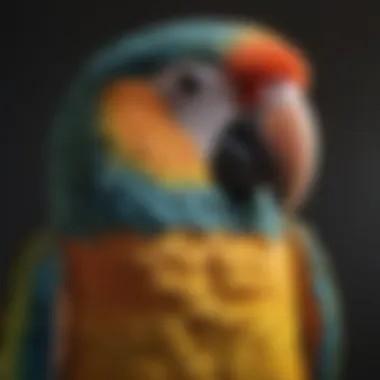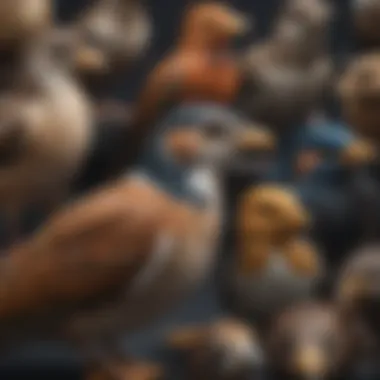Understanding the Avian Collar: Health and Safety


Intro
Avian collars serve an intriguing purpose in the world of pet bird care. As specialized accessories, these collars can aid in health management and behavioral training for birds. Many pet owners may not fully understand the range of functions that these collars can serve or the types available in the market. This section will clarify the significance of avian collars, enabling owners to make informed decisions regarding their use.
Understanding Your Pet
Pet Behavior Basics
To effectively use an avian collar, one must first grasp the basics of pet bird behavior. Birds, like many other pets, communicate through body language and vocalizations. Understanding their signals can help owners assess what might be necessary for behavioral adjustments.
Common behaviors such as screaming, biting, or feather plucking often signal the need for intervention. An avian collar may play a role in redirecting these behaviors. However, employing a collar requires an understanding of the underlying causes, such as stress, boredom, or health issues.
Common Breed Characteristics
Bird species differ greatly in behavior and requirements. For example, a cockatiel might be more sociable, while a parakeet can be quite chatty. Knowing these differences can be indicative of how a collar may be introduced. The collar, in some instances, might calm an excitable bird, whereas for others, it may not be necessary.
Species-Specific Needs
Each species has unique needs. For instance, larger birds like macaws often require a more robust collar designed to suit their size and temperament. Providing appropriate collars ensures that the accessory complements their nature, rather than restrict it. Over time, this understanding allows owners to tailor care practices that positively impact their pet’s welfare.
Pet Care and Maintenance
Feeding Guidelines
Proper nutrition is vital for the overall health of birds. Pet owners should provide a balanced diet that includes seeds, pellets, and fresh fruits and vegetables. Understanding nutritional requirements is essential for preventing health issues that may necessitate the use of a collar for monitoring.
Grooming Essentials
Regular grooming keeps a pet bird healthy and comfortable. This includes nail trimming, feather care, and beak maintenance. A well-groomed bird is less likely to experience anxiety, which can contribute to behavioral problems.
Hygiene Practices
Maintaining hygiene significantly reduces the chance of illnesses. Regular cage cleaning, providing fresh water, and monitoring feather condition are crucial practices for any bird owner. These routines ensure that a healthy environment is established, which is always beneficial when implementing tools like collars.
Training and Development
Basic Commands and Skills
Introducing basic commands and skills facilitates a strong bond between the pet and owner. Commands like "come" or "stay" can be reinforced with positive reinforcement. Collars can sometimes assist in training, providing a gentle indication during these early training periods.
Behavioral Training Techniques
Techniques for behavioral training often vary, depending on the bird's temperament and species. Established methods like clicker training can be effective. Using collars within these frameworks can help ease the transition to desired behaviors, but only if applied correctly and thoughtfully.
Addressing Common Behavior Issues
Common behavior issues, such as aggression or fearfulness, often call for immediate attention. Addressing these concerns is critical to the bird’s well-being. The temporary use of collars can support training but should not replace behavioral modification strategies.
Health and Wellness
Routine Vet Check-ups
Regular veterinary visits enable early detection of potential health issues. Collars may sometimes be used to monitor birds post-visit or after surgical procedures. Establishing a routine care regime proves vital in maintaining overall health.
Vaccination Needs


Birds, like other pets, require vaccinations to protect against certain diseases. Staying informed on vaccination schedules is crucial for avian health. Collars may assist in keeping track of vaccination history, offering a tangible reminder for owners.
Recognizing Signs of Illness
It is vital for owners to recognize signs of illness, such as lethargy or changes in eating habits. Early identification can lead to better outcomes for treatment. An avian collar can sometimes provide indicators if a bird is wearing it during a vet visit.
Enrichment and Activities
Indoor vs. Outdoor Activities
Bird enrichment plays a significant role in their mental and physical health. Indoor and outdoor activities both have their merits. For instance, outdoor exposure provides natural stimulation, while indoor activities can be tailored to a bird’s preferences.
Interactive Toys and Games
Keeping birds engaged with interactive toys is essential for mental stimulation. Toys that encourage foraging or problem-solving can reduce boredom-related behaviors. Collars can be introduced during playtime to ensure safety.
Socialization Opportunities
Socialization is vital to a bird’s development. Allowing for supervised interactions with other birds or humans can enhance their social skills. The thoughtful application of avian collars may assist in managing these interactions, ensuring safety and comfort.
Understanding the full context of avian collars opens doors to improved bird welfare and ownership experience. Each facet plays a role in how collars can optimize care practices, leading to healthier, happier birds.
Prologue to Avian Collars
Avian collars have emerged as key accessories in the realm of bird care, serving distinct purposes that significantly benefit both pet owners and their feathered companions. Understanding avian collars is essential for responsible pet ownership. These collars are not merely aesthetic items; they play a crucial role in behavioral management, health monitoring, and overall safety. In a world where the demands of avian welfare are constantly evolving, the introduction of collars becomes imperative for those who seek to ensure their birds lead healthy lives.
One primary purpose of an avian collar lies in its ability to affect a bird’s behavior positively. For example, some collars are designed to alleviate behavioral issues such as excessive feather plucking. This approach not only helps the bird but relieves owner stress as well. Moreover, these collars can provide essential health monitoring. Some advanced models track a bird's activity levels and can signal health issues before they become critical.
As beneficial as collars may be, there are several considerations that potential users should keep in mind. The choice of collar varies depending on the bird's species, health, and behavior. Additionally, proper fitting and monitoring the bird's reaction to the collar are critical for its effectiveness and the bird's comfort.
“Understanding the function and purpose of avian collars brings pet ownership to a higher level, enhancing both safety and well-being.”
Furthermore, avian collars must be used with caution. Misuse can lead to discomfort or even serious injuries. Therefore, it is vital to delve deeper into the definition, purpose, and varied types of avian collars to appreciate their benefits fully.
In the following sections, we will explore the specifics of different types of avian collars, materials used in their construction, benefits associated with their use, concerns regarding their application, and tips for selecting the right collar for your bird.
Types of Avian Collars
Understanding the different types of avian collars is essential for pet owners seeking to enhance the health and wellbeing of their birds. Each collar serves a distinct purpose, and the decision to use one should be based on the specific needs of the bird. This section delves into the three main categories of avian collars: behavioral training collars, protective collars, and health monitoring collars. Knowing the differences and benefits can help in selecting the appropriate collar for a particular situation.
Behavioral Training Collars
Behavioral training collars are designed specifically to assist pet owners in managing undesirable behaviors in birds. These collars can facilitate training by providing gentle cues or restrictions. For example, some collars might restrict a bird's ability to reach certain areas, thereby preventing harmful behaviors such as excessive feather plucking.
The success of these collars often depends on the owner's consistency in training and behavior management. Positive reinforcement should always be a part of the training process. It is important that owners use these collars judiciously, addressing not just the behavior but also the underlying causes, such as stress or environmental factors. Additionally, these collars should never replace proper training but serve as a supplemental tool that aids in modifying behavior.
Protective Collars
Protective collars play a crucial role in safeguarding birds from potential harm. These collars are primarily used to prevent a bird from accessing injuries or wounds on their bodies. When birds experience injuries, they may instinctively peck at them, leading to further damage. A protective collar can serve to keep the bird from reaching the affected area, allowing for proper healing time.
Materials used for protective collars can vary, with some being soft and flexible, while others are more rigid. Care must be taken to choose a collar that is comfortable, ensuring that it does not cause additional stress or discomfort to the bird. Regular monitoring is essential to ensure that the collar fits properly and does not impede the bird's natural behaviors or activities.
Health Monitoring Collars
Health monitoring collars offer an advanced way of keeping track of a bird's health. These collars often come equipped with technology that can provide real-time data on a bird's behavior, activity levels, and even physiological signs. Such information can be invaluable for early detection of potential health issues.


Some health monitoring collars track movement patterns, offering insights into changes in a bird's activity level, which may indicate discomfort or illness. Other collars can monitor vital signs, sending alerts to owners about any abnormal readings. While these collars can enhance a pet owner's ability to care for their birds, they should not replace routine veterinary check-ups or professional assessments. Instead, they should complement regular care, providing more detailed insights into the bird's daily health.
Materials and Design
The materials and design of avian collars play a crucial role in their effectiveness and the comfort of the birds that wear them. Selecting the right materials can influence how the collar interacts with the bird's body, potential durability, and even its overall aesthetic appeal. For pet owners, understanding these elements is essential in ensuring both the functionality of the collar and the welfare of their birds.
Common Materials Used
Avian collars are typically constructed from a range of materials, each serving a specific purpose. Some common materials include:
- Nylon: Known for its durability, nylon is often used in behavioral training collars. It is lightweight and can withstand wear and tear from daily use.
- Cotton: This natural fiber is frequently chosen for its softness. Cotton collars are gentle on the bird’s skin, which reduces the risk of irritation.
- Plastic: Used in some types of protective collars, plastic is rigid and can provide a barrier against environmental hazards. However, it should be made from non-toxic materials to ensure safety.
- Rubber: Flexible and soft, rubber collars are often used in health monitoring collars. They can adjust to the bird's movements without causing discomfort.
Each material possesses unique properties that make it suitable for specific functions, which pet owners should consider when selecting the best option for their birds.
Ergonomics and Comfort
Ergonomics is a significant factor in the design of avian collars. The collar should fit well without imposing stress on the bird. A collar that is too tight can restrict movement and cause discomfort, while one that is too loose may not serve its purpose effectively.
Comfort is vital for acceptance. If a bird finds the collar bothersome or restrictive, the intended benefits can be undermined. Therefore, here are a few considerations:
- Adjustability: Collars should have adjustable features to cater to different sizes and ensure a snug fit.
- Padding: Consider collars that come with padding or soft edges, which can enhance comfort and reduce the risk of skin irritation.
- Weight: Lightweight collars are preferred. Birds should not feel weighed down or distracted by their collar, which can lead to stress and behavioral issues.
By focusing on ergonomics and comfort, pet owners can significantly improve their birds' quality of life when using collars, enabling a better experience for both the bird and the owner.
Benefits of Using Avian Collars
Avian collars serve multiple beneficial roles for both birds and their owners. Recognizing these benefits is essential for anyone considering their use. Birds can greatly enhance their quality of life through proper application of avian collars. With careful consideration and informed use, collars can aid in behavioral management, provide safety features, and support health monitoring.
Behavioral Management
Behavioral issues in pet birds can significantly affect their wellbeing and the harmony of their environment. Avian collars can assist in managing these problems effectively. For instance, when used for behavioral training, collars can provide a physical boundary for birds during training sessions. This helps reinforce learning and discourage unwanted behaviors.
Additionally, collars can be used to limit certain actions. Some birds may exhibit destructive behaviors, such as feather plucking or aggressive interactions. In such cases, a collar may be used as an intervention tool. It is important for the owner to monitor their bird’s reactions to the collar. With continued observation, more suitable and positive behavioral habits can be encouraged.
Safety and Protection
Safety is another critical aspect where avian collars excel. Birds are naturally curious creatures, often leading them to hazardous situations. Collars can serve as a protective barrier, especially for outdoor use. This reduces the likelihood of birds getting into dangerous areas or possibly flying away.
Moreover, collars designed specifically for safety can help prevent injuries from sharp objects or wild animals. Providing a structured and safe space for birds goes a long way in ensuring their wellbeing. It allows owners to allow their birds some freedom without constant worry about potential dangers.
Health Monitoring Advantages
Health monitoring is a fundamental benefit of avian collars. Some collars come equipped with technology that helps monitor a bird's physical condition. This could include tracking activity levels, heart rates, or other critical health metrics.
Monitoring health closely can lead to early detection of potential health problems. By analyzing data from these collars, owners can be proactive when it comes to their bird's health. This is particularly beneficial for aging birds or those with known health issues. Regular health checks can lead to timely veterinary interventions, which can be lifesaving.
Concerns and Risks Associated with Avian Collars
Understanding the concerns and risks linked to avian collars is essential for pet owners who want to prioritize their birds' well-being. While collars offer various benefits, their potential downsides need careful consideration. Each type of collar has specific applications but also may pose challenges that could impact a bird's health and behavior. For pet owners, recognizing these risks can lead to more informed decisions regarding their use.
Potential Harm or Discomfort
Avian collars can sometimes cause physical harm or discomfort to birds. If improperly fitted, a collar can irritate the skin or impede the bird’s movements. This is crucial for species that rely on agility and freedom of motion. Signs of discomfort can include frequent scratching, agitation, or changes in behavior. Additionally, collars that are too tight may restrict the bird's breathing or blood circulation. Ensuring proper fit and regularly checking for signs of distress can mitigate such risks.
"A well-fitted collar should allow for movement while providing the needed support or restriction."


It is important for owners to consult with avian veterinarians when selecting a collar, as they can recommend appropriate sizes and types based on individual bird needs.
Misuse of Collars
Misuse is a common issue with avian collars. Some pet owners may find collars beneficial for training but may not grasp the correct application. Using behavioral collars for avian training without understanding their purpose can lead to negative outcomes. For instance, avian collars intended for behavioral training may inadvertently become tools of punishment if misapplied.
Furthermore, owners sometimes underestimate the psychological impact of collars on their pets. Birds might feel anxious or overwhelmed when restricted, leading to stress-related behaviors. Educating oneself on the respective functions and appropriate usage is vital for any collar application.
Alternatives to Collars
For those who are wary of using collars, there are several alternatives to consider. Behavioral training can be achieved through positive reinforcement techniques, which do not necessitate any restriction. Engaging birds with various toys or environmental enrichment can also fulfill both behavioral needs and stress relief.
- Positive Reinforcement: Rewarding with treats or praise can redirect unwanted behaviors.
- Environmental Enrichment: Providing stimulating toys or varied foraging activities can reduce stress and improve overall well-being.
- Training Sessions: Short and frequent exercises can help a bird learn without the use of a collar.
Ultimately, each bird is unique, and careful evaluation of their needs and behaviors will facilitate making the best choice for their care.
Selecting the Right Collars
Choosing the appropriate collar for birds requires careful consideration. Each type of collar serves a distinct purpose and offers different benefits. Selecting the right collar ensures that the bird’s health and wellbeing are maintained. A collar that fits poorly or serves an incorrect purpose can lead to discomfort or even harm.
Consultation with Professionals
Before making a decision on what collar to use, it is crucial to speak with veterinary professionals or avian specialists. These experts possess knowledge that can guide bird owners toward the most suitable collar for their specific needs. They can help identify the bird’s behavioral issues or health concerns that a collar might address.
Some professionals may recommend a specific brand or type based on the bird's species, size, and unique needs. Consulting with the right experts can lead to better outcomes for both the owner and the bird. This step is fundamental in understanding whether a collar may help or cause additional stress.
Evaluating Individual Bird Needs
Every bird is unique. Owners need to assess their individual bird's characteristics when selecting a collar. Factors to consider include the bird’s size, breed, health status, and temperament.
- Size and Breed: Different species have different anatomical structures. A collar designed for a larger bird, like a Macaw, will not be suitable for a smaller bird, like a Budgerigar.
- Health Status: If a bird has preexisting conditions, special collars may be needed to cater to those health requirements.
- Temperament: A more anxious bird might require a collar that is less restrictive or more comfortable, whereas a more docile bird may adapt easily to various designs.
The process of evaluating needs should involve observing the bird’s behavior without a collar first. Determine if there are specific actions or behaviors that correspond with issues the collar aims to address. Observations made during this time can inform owners about what features they should prioritize in a collar.
Application of Avian Collars
The application of avian collars is pivotal in addressing the various needs of pet birds. This section emphasizes the significance of correct collar use, which can achieve effective results in behavioral management and health monitoring. Collars serve not only as tools for correction but also ensure the safety and overall well-being of birds. This part of the article will outline essential elements, benefits, and considerations for collar application.
Fitting the Collar Properly
Fitting an avian collar properly is vital for both comfort and effectiveness. A collar that is too tight can restrict movement and cause discomfort, while one that is too loose might not serve its intended purpose. To ensure proper fitting, follow these guidelines:
- Measure the Neck: Use a soft tape to measure the bird's neck circumference. This measurement helps in selecting the right collar size.
- Check for Movement: The collar should allow for some movement, but not excessive. Ensure that the bird can tilt its head and open its beak without straining.
- Adjustable Collars: Whenever possible, opt for adjustable collars. These allow for modifications as the bird grows or if its weight changes.
Most importantly, collars made from lightweight materials tend to be more comfortable for birds. Regular checks are necessary to ensure the fit remains appropriate as the bird adapts.
Monitoring the Bird’s Reaction
Monitoring how a bird reacts to an avian collar is essential for assessing its suitability and effectiveness. Bird behavior can change when wearing a collar, and understanding these changes can provide insights into its comfort level. Here are some factors to observe:
- Initial Reactions: Noting how the bird behaves immediately after fitting the collar can be telling. Signs of distress, such as pacing or vocalizing, should prompt immediate reassessment of the collar’s fit.
- Long-Term Behavior: Over time, observe any changes in activity levels or eating habits. A stressed bird may exhibit decreased interest in food or play.
- Physical Symptoms: Keep an eye out for any physical indicators of irritation, such as redness or sores around the collar area.
"Monitoring a bird's reaction can make all the difference in ensuring its comfort and well-being. Adjustments may be necessary based on these observations."
By closely watching a bird after collar application, owners can make informed decisions whether to modify the collar or even consider alternatives.
Ending
In the discussion of avian collars, it is essential to summarize their significance in the overall care and well-being of birds. Collars serve various functions, from aiding in behavioral management to providing health monitoring. Their thoughtful application can enhance both the safety and comfort of pet birds, thus improving their quality of life. However, the risks associated with their misuse cannot be overlooked. Understanding the implications of using avian collars allows pet owners to make informed decisions.
Key Takeaways
- Understanding Functionality: Avian collars are designed with specific purposes in mind. Their varied functions include behavioral training, protection from harmful behaviors, and health monitoring.
- Assessing Individual Needs: Each bird is unique. It is crucial to evaluate the needs of each pet bird before selecting a collar type.
- Professional Consultation: Engaging with avian professionals can provide valuable insights, ensuring the appropriate application of collars.
- Monitoring and Adjustment: Continuous monitoring is vital. Observing the bird’s behavior with the collar on can help in making necessary adjustments.







